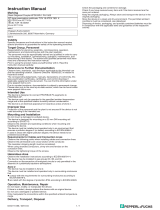Page is loading ...

Instruction Manual
1. Marking
Relay module
KFD0-RSH-1.1D.F1
Certificate: PF 15 CERT 3933 X
Marking: II 3G Ex nC ec IIC T4 Gc [device in zone 2]
North America Certificates:
Class I, Division 2, Groups A, B, C, D; T4 or non-hazardous area
Pepperl+Fuchs GmbH
Lilienthalstraße 200, 68307 Mannheim, Germany
Internet: www.pepperl-fuchs.com
2. Target Group, Personnel
Responsibility for planning, assembly, commissioning, operation,
maintenance, and dismounting lies with the plant operator.
The personnel must be appropriately trained and qualified in order to carry
out mounting, installation, commissioning, operation, maintenance, and
dismounting of the device. The trained and qualified personnel must have
read and understood the instruction manual.
Prior to using the product make yourself familiar with it. Read the
instruction manual carefully.
3. Reference to Further Documentation
Observe laws, standards, and directives applicable to the intended use
and the operating location.
The corresponding datasheets, manuals, declarations of conformity, EU-
type examination certificates, certificates, and control drawings if
applicable supplement this document. You can find this information under
www.pepperl-fuchs.com.
If you use the device in safety-related applications, observe the
requirements for functional safety. You can find these requirements in the
functional safety documentation under www.pepperl-fuchs.com.
4. Intended Use
The device is only approved for appropriate and intended use. Ignoring
these instructions will void any warranty and absolve the manufacturer
from any liability.
The device is used in control and instrumentation technology
(C&I technology). The device is designed for safety-related switching of
load circuits.
Use the device only within the specified ambient and operating conditions.
The device is designed for mounting on a 35 mm DIN mounting rail
according to EN 60715.
Only use the device stationary.
The device is an electrical apparatus for hazardous areas of Zone 2.
The device is an electrical apparatus for hazardous areas of Class 1,
Division 2 or Class I, Zone 2.
If you use the device in safety-related applications, observe the
information for safety function and safe state.
5. Improper Use
Protection of the personnel and the plant is not ensured if the device is not
used according to its intended use.
The device is not suitable for isolating signals in power installations unless
this is noted separately in the corresponding datasheet.
6. Mounting and Installation
Do not mount a damaged or polluted device.
Observe the installation instructions according to IEC/EN 60204-1.
Do not mount the device in the dust hazardous area.
Mount the device in a way that the device is protected against mechanical
hazard.
The device fulfills a degree of protection IP20 according to IEC/EN 60529.
The device must be installed and operated only in surrounding enclosures
that are rated with the degree of protection IP54 according to
IEC/EN 60529.
The device must be installed and operated only in a controlled
environment that ensures a pollution degree 2 (or better) according to
IEC/EN 60664-1.
If used in areas with higher pollution degree, the device needs to be
protected accordingly.
The device must be installed and operated only in an environment of
overvoltage category II (or better) according to IEC/EN 60664-1.
If you install the device in safety-related applications, observe the
requirements for functional safety.
Requirements for Cables and Connection Lines
Observe the permissible core cross section of the conductor.
When using stranded conductors, crimp wire end ferrules on the
conductor ends.
Use only one conductor per terminal.
When installing the conductors the insulation must reach up to the
terminal.
Observe the tightening torque of the terminal screws.
If the voltage is greater than 50 V AC or 120 V DC, switch off the voltage
before connecting or disconnecting the device.
Requirements for Equipment Protection Level Gc
Observe the installation instructions according to IEC/EN 60079-14.
The device must be installed and operated only in surrounding enclosures
that
lcomply with the requirements for surrounding enclosures according to
IEC/EN 60079-0,
lare rated with the degree of protection IP54 according to
IEC/EN 60529.
Connection or disconnection of energized circuits is only permitted in the
absence of a potentially explosive atmosphere.
Requirements for Division 2
Observe the instructions according to NEC article 501.
Do not use the replaceable internal fuse. Remove the internal fuse.
In order to protect the circuit and the load, install an external fuse.
Only connect the external fuse to terminals 5 and 6. Do not use terminal 4.
7. Operation, Maintenance, Repair
If you operate the device in safety-related applications, observe the
requirements for functional safety. For the proof test, plan appropriate
intervals for the operation in low demand mode.
The device must not be repaired, changed, or manipulated. In case of
failure, always replace the device with an original device.
If the voltage is greater than 50 V AC or 120 V DC, switch off the voltage
before connecting or disconnecting the device.
The following safety instruction is symbolized via the warning marking on
the device.
Only change the replaceable fuse, when the device is de-energized.
Do not touch the hot surface of the device. Let cool down the device
surface before touching the device.
Requirements for Equipment Protection Level Gc
Connection or disconnection of energized circuits is only permitted in the
absence of a potentially explosive atmosphere.
Only change the replaceable fuse, when the device is de-energized.
8. Delivery, Transport, Disposal
Check the packaging and contents for damage.
Check if you have received every item and if the items received are the
ones you ordered.
Always store and transport the device in the original packaging.
Store the device in a clean and dry environment. The permitted ambient
conditions must be considered, see datasheet.
Disposing of device, packaging, and possibly contained batteries must be
in compliance with the applicable laws and guidelines of the respective
country.
DOCT-5079B / 2017-11 1 / 1
/
